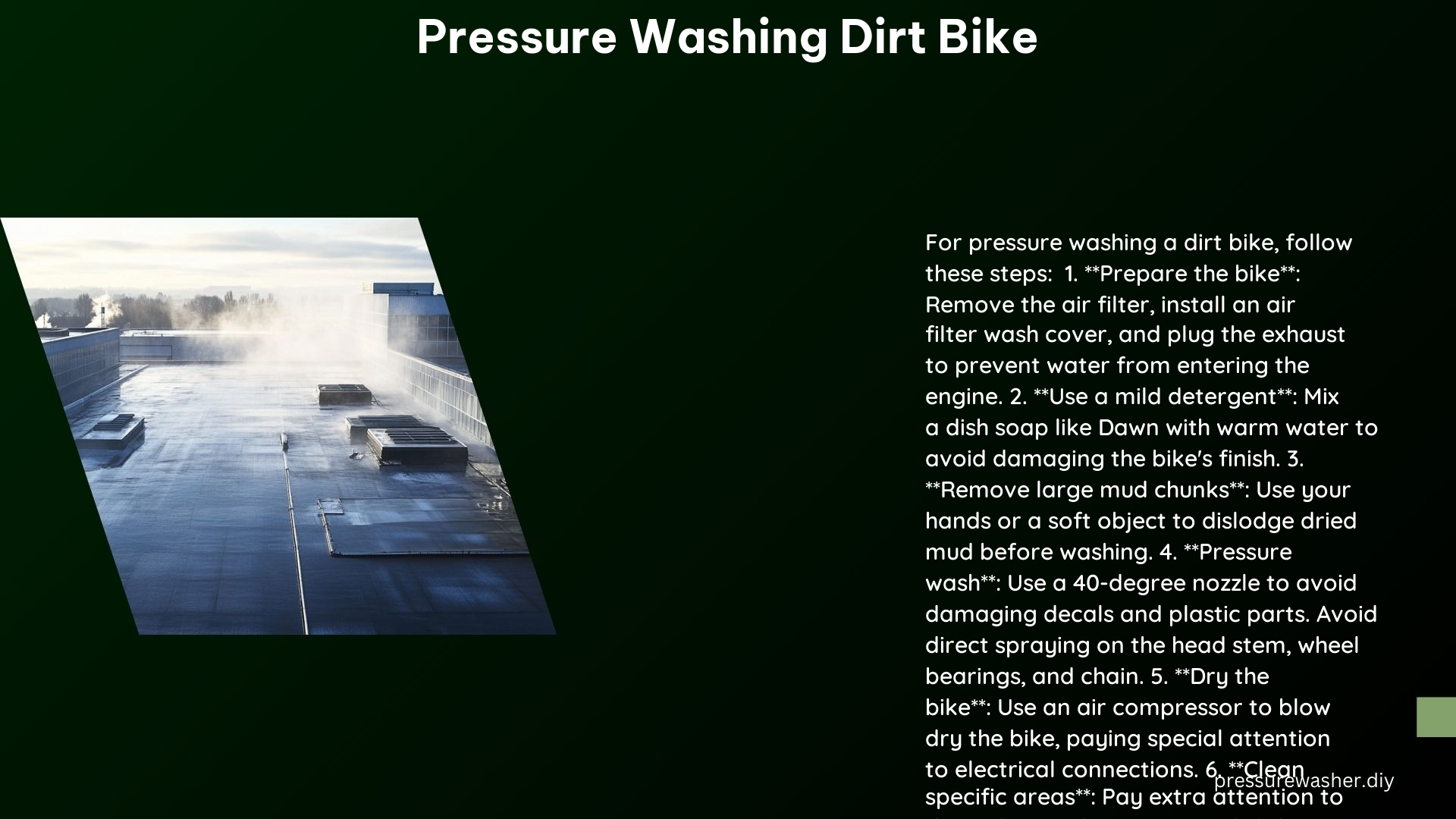Pressure washing a dirt bike can be a delicate process, requiring careful attention to avoid damaging the bike’s sensitive components. This comprehensive guide will provide you with the necessary technical details, best practices, and expert recommendations to ensure your dirt bike emerges from the wash looking and performing its best.
Recommended PSI for Pressure Washing a Dirt Bike
The optimal pressure (PSI) for pressure washing a dirt bike is a crucial consideration. Using too high of a pressure can potentially damage the bike’s seals, bearings, and other critical components. According to industry experts, the recommended PSI range for pressure washing a dirt bike is between 1,000 to 1,500 PSI.
| Pressure Washer Model | Recommended PSI Range |
|---|---|
| AR Blue Clean AR383 | 1,000 – 1,500 PSI |
| Karcher K5 Premium | 1,100 – 1,600 PSI |
| Simpson MSH3125-S | 1,200 – 1,700 PSI |
It’s important to note that the specific PSI recommendation may vary depending on the pressure washer model, the type of dirt or debris being removed, and the sensitivity of the dirt bike’s components. Always start with the lower end of the PSI range and gradually increase the pressure as needed, while closely monitoring the bike’s surface for any signs of damage.
Protecting Bearings and Seals

Protecting the bearings and seals of your dirt bike is crucial during the pressure washing process. These sensitive components can be easily damaged by high-pressure water, leading to premature wear and potential failure. To safeguard your dirt bike’s bearings and seals, follow these best practices:
-
Use a Wide-Angle Nozzle: Opt for a 40-degree nozzle attachment on your pressure washer. This wider spray pattern helps distribute the water pressure over a larger surface area, reducing the risk of concentrated water jets damaging the bearings and seals.
-
Avoid Direct Spraying: Refrain from directly spraying the head stem, wheel bearings, and chain with high-pressure water. This can force water into the seals, leading to corrosion and premature wear.
-
Utilize Protective Covers: Use a muffler plug and an airbox wash cover to prevent water from entering the engine and muffler during the washing process.
-
Inspect and Maintain Seals: Regularly inspect the condition of your dirt bike’s seals and replace them if necessary. Well-maintained seals are crucial for protecting the bearings and other internal components.
General Washing Tips
Proper washing techniques are essential for effectively cleaning your dirt bike without causing any damage. Follow these general washing tips to ensure a thorough and safe cleaning process:
-
Remove Large Mud Chunks: Before pressure washing, manually remove any large chunks of dried mud or debris from the bike’s surfaces. This will help prevent scratching or abrasion during the washing process.
-
Use a Mild Detergent: Choose a gentle, pH-neutral detergent, such as Dawn dish soap, to avoid damaging plastic parts or leaving residue on metal surfaces.
-
Utilize a Soft-Bristled Brush: Employ a soft-bristled brush to gently scrub the bike’s surfaces, ensuring a thorough clean without causing any scratches or surface damage.
-
Dry the Bike Thoroughly: After washing, use compressed air or a leaf blower to thoroughly dry the bike, paying special attention to electrical connections, bearings, and other sensitive areas.
Technical Specifications
To provide you with a specific example, let’s consider the technical specifications for the AR Blue Clean AR383 Electric Pressure Washer:
- Model: AR Blue Clean AR383 Electric Pressure Washer
- Maximum Pressure: 1,900 PSI
- Recommended PSI Range for Dirt Bikes: 1,000 – 1,500 PSI
- Detergent: Dawn dish soap or similar mild detergents
- Nozzle Angle: 40-degree nozzle
Additional Tips
To further enhance the effectiveness and longevity of your dirt bike’s cleaning routine, consider the following additional tips:
-
Regular Maintenance: Regularly washing and maintaining your dirt bike can help prevent the buildup of dirt and grime, making the cleaning process easier and more effective.
-
Use Protective Coatings: Apply undercoatings, such as AMSOIL Mudslinger, to help prevent mud and dirt from accumulating on the bike’s surfaces, making it easier to clean in the future.
-
Invest in High-Quality Cleaning Supplies: Opt for premium-quality pressure washers, detergents, and brushes to ensure optimal cleaning performance and minimize the risk of damage to your dirt bike.
-
Consult Manufacturer Recommendations: Always refer to your dirt bike’s manufacturer’s guidelines for specific cleaning and maintenance instructions to ensure you’re following their recommended best practices.
By following the technical details and best practices outlined in this comprehensive guide, you can effectively pressure wash your dirt bike while protecting its sensitive components and maintaining its peak performance.
Reference:
- https://www.thumpertalk.com/forums/topic/939426-pressure-washing-a-dirtbike-be-very-careful-scary-moment/
- https://www.vitalmx.com/forums/Moto-Related,20/Whats-your-pressure-wash-bike-detail-routine,1352242
- https://www.reddit.com/r/Dirtbikes/comments/14rcd70/pressure_wash_and_bike_is_still_dirty/
- https://blog.amsoil.com/how-to-wash-a-dirt-bike/
- https://www.dirtrider.com/features/protips/how-to-properly-wash-a-dirt-bike/
